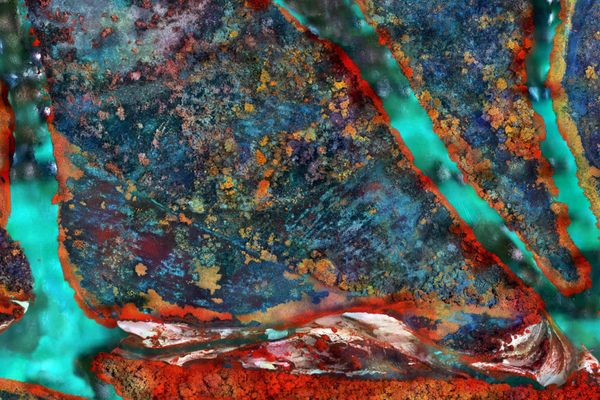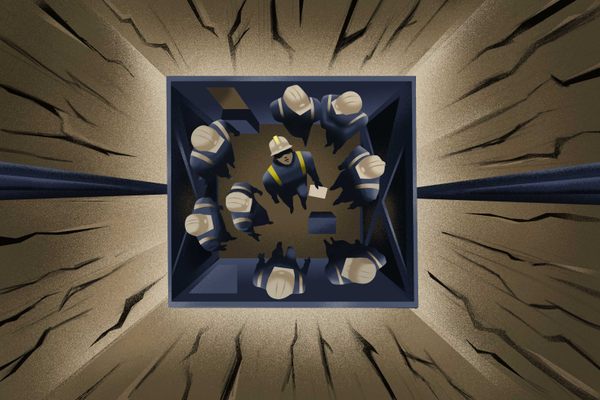
Our Favorite Science Stories of 2022
From engineering VR terror to tracking tipsy monkeys, we love watching researchers at work.
Science is a journey, not a destination. It’s an endless process of collecting data, devising a hypothesis, and then testing it from every angle like a velociraptor probing its enclosure fence. And it can get messy.
Just ask the paleontologists who had to push their stuck truck out of the mud on the way to a remote dig where finding fossilized poop would be their greatest success. Or the intrepid team that followed monkeys through the forest canopy as the animals noshed on boozy, fermented fruit. As drunks often do, the monkeys relieved themselves wherever and whenever nature called, including directly on the scientists. The when and where of peeing was also an issue for archaeologists and divers recording cave art about to be swallowed by rising sea levels: Working for hours in an environmentally sensitive underwater space, when they really had to go, they couldn’t.
Here are some of our favorite 2022 stories from scientists in the field, in all their messy glory.
An Ancient Croc Stepped in Poop and Created a Portal to the Past
by Kate Golembiewski
Most humans want to believe that we’ll leave our mark on the world in a meaningful way. But some 33 million years ago, one reptile wasn’t thinking about that when it stepped in its own feces. Little did that ancient animal know that paleontologists would one day find its preserved poop and, after slogging through mud and having an up-close encounter with a modern and very live crocodile, use it to uncover a lost ecosystem. (But first, they had to prove it wasn’t a fossilized penis.)

Monkeys Love Their Alcohol
by Sarah Durn, Associate Editor
For decades, some biologists have believed that the human appetite for alcohol has roots much deeper in our evolutionary family tree, and other primates, including monkeys, are also attracted to fermented sugars. A team in Panama put that hypothesis—and their nerve—to the test, following spider monkeys for days to collect discarded fruit and urine samples, sometimes unintentionally.
Behold Meraxes, Argentina’s Ancient ‘Giant Dragon’
by Gemma Tarlach, Senior Editor/Writer
Sometimes, a fossil turns the field of paleontology upside down. And sometimes paleontologists have to work upside down to find it. A team prospecting for dinosaur fossils in the broiling-hot Neuquén Province made a monster-sized discovery on the very first day of the dig: a giant predator new to science. Finding the fossil was one thing, but freeing it from its resting place was another. The skull and other precious pieces were exposed only from beneath—the opposite of how fossils are usually found—and were too large to carry out of the canyon. The paleontologists had to turn conventional field methods on their head and devise new ways of collecting the bones, including carting them out on an obliging local’s dune buggy.

The Race to Document Prehistoric Art in a Coastal Cave in France
by Elizabeth Hewitt
Nearly 30,000 years ago, Cosquer Cave was a few miles inland from the Mediterranean coast. Today, it’s more than 120 feet underwater, thanks to sea level rise following the last ice age. Two chambers deep within the cave remain partly dry, their walls decorated with ancient art. But the sea is relentless: Water levels are rising again, this time because of climate change. The art can’t be saved, but it can live on digitally, thanks to the dedication and ingenuity of expert divers and archaeologists—including one who learned to dive just so he could brave perilous underwater passages and study the site in person.
Can Science Solve the Mystery of the Concrete Book?
by April White, Senior Editor/Writer
It’s been more than 50 years since Wolf Vostell encased 100 booklets in individual slabs of concrete—allegedly. Questions have surrounded what, if anything, the cheeky German artist buried in these hefty blocks. To crack the case without cracking open the artwork, Chicago curators and scientists tested an arsenal of noninvasive tech more commonly used to study fossils and particle physics.
This Bogotá Market Comes Alive Only At Night, Full of Ancient Plant Lore and Astonishing Biodiversity
by María Paulo Rubiano A.
Around the world, city markets are vibrant microcosms of culture and history, color and scent. Even by those standards, the market at Plaza Samper Mendoza in the Colombian capital is special: At sunset, farmers and foragers from around the country set up stalls full of herbs and other plants used in traditional medicine and cooking. When botanists and other researchers conducted the first-ever scientific survey of species available at the market, the team’s leader says he was left speechless by what they found.

A ‘Weird’ Ancient Marine Reptile Surfaces Thanks to the ‘Bone Biddies’
by Gemma Tarlach, Senior Editor/Writer
Forget the Hollywood cliche of a paleontologist swashbuckling across badlands. The work of preparing a fossil for study, including the tedious, tricky job of freeing it from surrounding rock, is often done by unsung volunteers. At one Wyoming museum, an amiable group of grannies considers fossil preparation—including their latest project, a remarkable new plesiosaur—as their version of a quilting bee.
Why Horror Is So Damned Fun
by Samir S. Patel, Editor in Chief
At the end of a dark, remote road in Denmark, for one month every year, all hell breaks loose, and scientists are there to document every shriek and shudder. The annual Halloween attraction known as Dystopia is one subject of the Recreational Fear Lab, where a dedicated team is unraveling how we respond to scares and why some of us can’t get enough. Spoiler alert: Our intrepid editor straps on a VR headset to experience what’s essentially “a machine that eats fear to trap you in your own nightmares.” Sweet dreams, dear reader.















Follow us on Twitter to get the latest on the world's hidden wonders.
Like us on Facebook to get the latest on the world's hidden wonders.
Follow us on Twitter Like us on Facebook